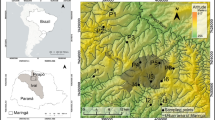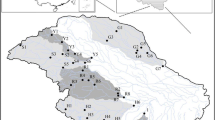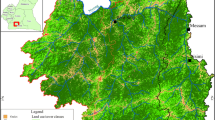Abstract
Researchers generally accept that land use types within a watershed closely relate with the water quality characteristics of streams. Despite numerous studies investigating the relationships between water quality and land use, there are increasing concerns about the geographical variation and lack of spatial integration in previous studies. We investigated the relationships between land use and water quality characteristics including biological oxygen demand (BOD5), total nitrogen (TN), total phosphorus (TP), and Escherichia coli in the Wha-Ong estuarine reservoir watershed in Korea, which has spatially integrated land uses. Residential and paddy areas appear to be positively and negatively correlated, respectively, with degraded water quality. The spatial variations of these relationships were also examined using zonal analysis. Some results contrasted with those of previous studies that were conducted mostly in developed Western countries and may reflect the different land use intensities and agricultural practices in Korea. Relationships across zones, distinguished by distances from streams, were inconsistent and erratic, suggesting that the relationships between remote land uses and water quality may be affected more significantly by sub-basin characteristics than by the land use itself. The geographical differences and spatial variations found in this study indicate that caution must be taken in generalizing the relationship between land use and water quality.


Similar content being viewed by others
References
Allan JD, Johnson L (1997) Catchment-scale analysis pf aquatic ecosystems. J Freshw Biol 37:107–111
Anbumozhi V, Radhakrishnan J, Yamaji E (2005) Impact of riparian buffer zones on water quality and associated management considerations. Ecol Eng 24:517–523
Arheimer B, Liden R (2000) Nitrogen and phosphorus concentrations from agricultural catchments-influence of spatial and temporal variables. J Hydrol 227(1–4):140–159
Baker A (2003) Land use and water quality. Hydrol Process 17:2499–2501
Bolstad PV, Swank WT (1997) Cumulative impacts of land use on water quality in a southern Appalachian watershed. J Am Water Resour Assoc 33(3):519–534
Buck O, Niyogi DK, Townsend CR (2004) Scale-dependence of land use effects on water quality of streams in agricultural catchments. Environ Pollut 130:287–299
Delong DD, Brusven MA (1991) Classification and spatial mapping of riparian habitat with application toward management of streams impacted by nonpoint source pollution. J Environ Manage 15(4):565–571
Fisher DS, Steiner JL, Endale DM, Stuedemann JA, Schomberg HH, Franzluebbers AJ, Wilkinson SR (2000) The relationship of land use practices to surface water quality in the Upper Oconee Watershed of Georgia. For Ecol Manage 128:39–48
Gardi C (2001) Land use, agronomic management and water quality in a small Northern Italian watershed. Agric Ecosyst Environ 87:1–12
Gburek WJ, Folmer GJ (1999) Flow and chemical contributions to streamflow in an upland watershed: a baseflow survey. J Hydrol 217:1–18
Griffith JA (2002) Geographic techniques and recent applications of remote sensing to landscape-water quality studies. Water Air Soil Pollut 138:181–197
Johnson L, Richard C, Host G, Arthur J (1997) Landscape influences on water chemistry in Midwestern stream ecosystems. J Freshw Biol 37:193–208
LeBlanc RT, Brown RD, FitzGibbon JE (1997) Modeling the effects of land use change on the water temperature in unregulated urban streams. J Environ Manage 49:445–469
Lee MD, Bastemeijer TF (1991) Drinking water source protection: a review of environmental factors affecting community water supplies. Occasional Paper 15. IRC International Water and Sanitation Centre, The Hague, pp 5–34
Lenat DR, Crawford JK (1994) Effects of land use on water quality and aquatic biota of three North Carolina Piedmont Streams. Hydrobiologia 294(3):185–200
Liu A., Tong STY, Goodrich JA (2000) Land use as a mitigation strategy for the water-quality impacts of global warming: a scenario analysis on two watersheds in the Ohio River Basin. Environ Eng Policy 2:65–76
Marsh WM (1997) Landscape planning; environmental applications. Wiley, New York, pp 148–150
Nakamura K, Nakayama H, Hideshma Y, Ishida T, Ogikibo J, Moriwaki S (2001) Drainage flows in grass and forest slope lands. In: Proceedings of the JSIRDE Annual Meeting 44–45
Ngoye E, Machiwa JF (2004) The influence of landuse patterns in the Ruvu river watershed on water quality in the river system. Phys Chem Earth Sci 29:1161–1166
Omernik JM, Abernathy AR, Male LM (1981) Stream nutrient levels and proximity of agricultural and forest land to streams. Some relationships. J Soil Water Conserv 36:227–231
Osborne LL, Wiley MJ (1988) Empirical relationship between land use/cover and stream water quality in an agricultural watershed. J Environ Manage 26:9–27
Ren W, Zhong Y, Meligrana J, Anderson B, Watt WE, Chen J, Leung H-K (2003) Urbanization, land use, and water quality in Shanghai. Environ Int 29:649–659
Sliva L, Williams DD (2001) Buffer zone versus whole catchment approaches to studying land use impact on river water quality. Water Res 35(14):3462–3472
Tong STY, Chen W (2002) Modeling the relationship between land use and surface water quality. J Environ Manage 66(4):377–393
Vought LB-M, Pinay G, Fuglsang A, Ruffinoni C (1995) Structure and function of buffer strips from a water quality perspective in agricultural landscape. Landsc Urban Plan 31:323–331
Wear D, Turner M, Naiman R (1998) Land cover along an urban–rural gradient: implication for water quality. Ecol Appl 8:619–630
Woli KP, Nagumo T, Kuramochi K, Hatano R (2004) Evaluating river water quality through land use analysis and N budget approaches in livestock farming areas. Sci Total Environ 329:61–74
Acknowledgments
This study was carried out with the support of “Specific Joint Agricultural Research-promoting Projects (Project No. 20070101-033-220-001-01-00)”, RDA, Republic of Korea.
Author information
Authors and Affiliations
Corresponding author
Rights and permissions
About this article
Cite this article
Jung, KW., Lee, SW., Hwang, HS. et al. The effects of spatial variability of land use on stream water quality in a costal watershed. Paddy Water Environ 6, 275–284 (2008). https://doi.org/10.1007/s10333-008-0122-1
Received:
Accepted:
Published:
Issue Date:
DOI: https://doi.org/10.1007/s10333-008-0122-1




